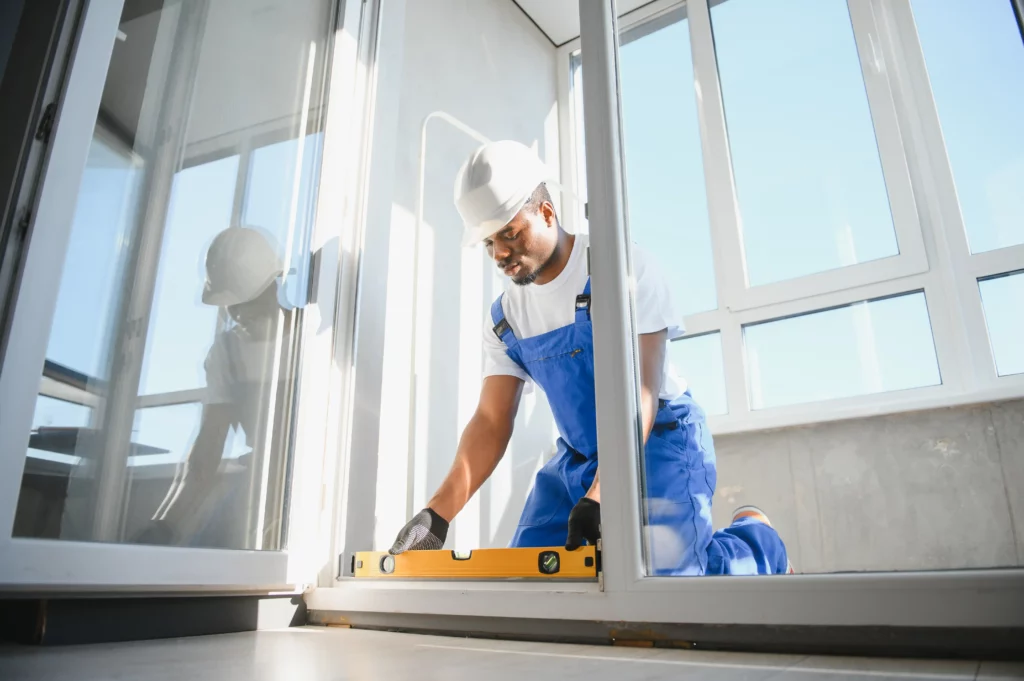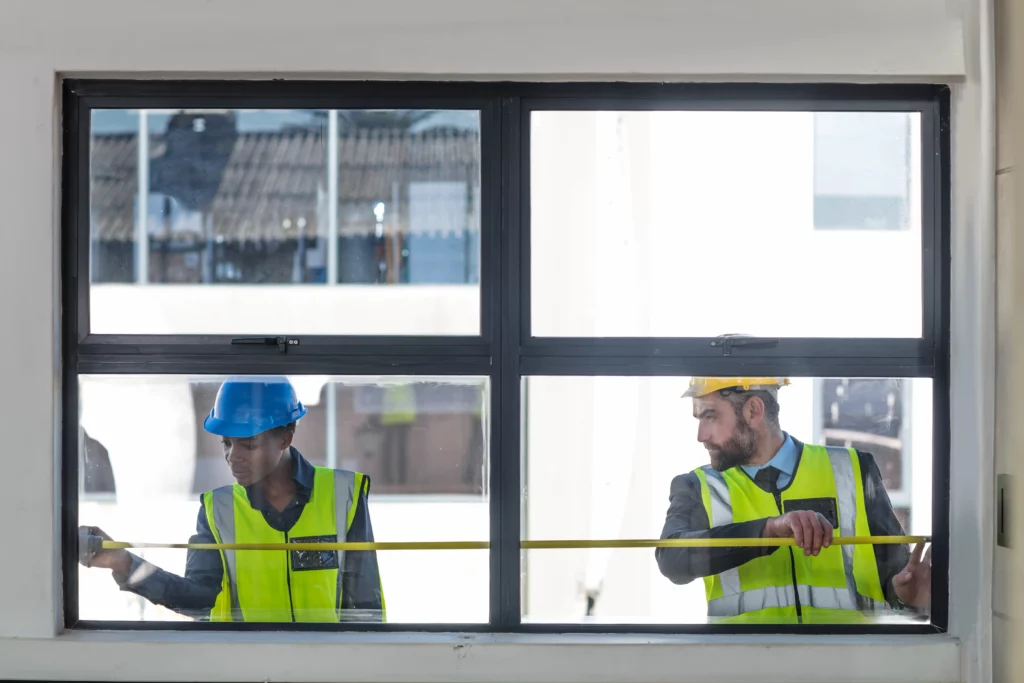When you install impact windows badly, it can get pricey especially when water damage occurs, even with high-quality hurricane-resistant products. Your coastal home needs proper impact window installation, especially in hurricane-prone areas like Jupiter, Miami, and Palm Beach. Wrong flashing and waterproofing methods could leave your home’s storm protection vulnerable to moisture problems.
The International Residential Code (IRC) sets clear flashing requirements to stop water damage. Your contractor must install flashing in a shingle-fashion pattern that extends to the exterior wall finish or water-resistive barrier. The pan flashing needs to extend up the rough jamb by 6 inches and cover 2 inches of the wall surface to drain water effectively. Hurricane-proof windows need special care during installation. They must handle severe wind pressures and flying debris while keeping a watertight seal.
This piece walks you through installing impact windows that meet 2025 code requirements. We’ll show you everything from rough opening prep to applying self-adhesive flashing and using the right sealants. Your coastal home will stay protected from storms and water damage.
Understanding Impact Windows for Coastal Homes
Impact windows are a major breakthrough in protective building technology for coastal properties. These specialized products offer better defense against extreme weather conditions than conventional windows through their unique construction and design features.
What Makes a Window ‘Impact Rated’?
Impact-rated windows use multiple layers of protection to withstand hurricane-force winds and flying debris. The heart of an impact window lies in its specialized glass construction, which uses minimum two layers of glass bonded with a strong, flexible polymer interlayer. This polymer layer—usually polyvinyl butyral (PVB) or ethylene-vinyl acetate (EVA)—keeps glass fragments together even after breaking and maintains the window’s structure.
Windows need to pass tough testing procedures that mirror real-life hurricane conditions to get an impact rating. Testing involves firing a 2×4 lumber missile at the window at speeds of 50 feet per second. This simulates windborne debris like tree branches or building materials that become dangerous projectiles during severe storms.
Impact windows also need stronger frames to support the heavier glass packages. Regular window frames can’t properly hold impact-resistant glass because it’s much thicker and heavier than standard glass. The frames must be built from strong materials like aluminum, fiberglass, or metal-clad wood to give enough structural support.
ASTM E1996 and E1886 Compliance Explained
The American Society for Testing and Materials (ASTM) has two main standards that are the foundations of impact window certification: E1996 and E1886. These standards determine if windows can handle hurricane conditions.
ASTM E1996 details how windows should perform when hit by windborne debris during hurricanes. Windows get classified based on how well they resist different types of impacts—large missile tests for areas within 30 feet of grade and small missile tests for higher elevations. Large missile tests use wooden 2x4s, while small missile tests use steel balls to simulate smaller flying objects like roof gravel.
ASTM E1886 describes the test methods to evaluate window performance. The test has two main parts:
- Impact testing where missiles hit the window
- Cyclic pressure testing that copies the positive and negative wind pressures windows face during a hurricane
It’s worth mentioning that windows must handle thousands of pressure cycles after impact, according to ASTM E1886. This proves the window will stay intact throughout an entire storm, not just survive the first hit.

Differences When You Install Impact Windows vs. Hurricane Windows
People often mix up impact and hurricane windows, but they have key differences in their construction and protection levels.
Hurricane windows mainly focus on wind resistance and use one or two layers of PVB laminate. These windows can handle high-speed winds but might not protect as well against direct hits from flying debris.
Impact windows use thicker panes with multiple layers of glass and laminate, making them better at handling direct impacts. They have more plastic compared to glass, which gives better protection against both wind pressure and physical impacts.
Here’s how they stack up:
| Characteristic | Hurricane Windows | Impact Windows |
| Glass Construction | 1–2 layers of PVB laminate | Multiple layers of PVB/PET laminate |
| Weight | Lighter | Heavier and thicker |
| Frame Requirements | Standard reinforced frames | Stronger, specialized frames |
| Debris Resistance | May crack but retains integrity | Less likely to crack, higher impact resistance |
| Energy Efficiency | Standard | Superior due to thicker construction |
| Noise Reduction | Minimal | Significant |
Impact windows are a great way to get extra benefits for coastal homeowners. They improve energy efficiency with thicker panes, reduce noise, block up to 99% of harmful UV rays, and boost security against break-ins.
Make sure your impact windows meet local building codes and have proper certifications for your region before installation. Many coastal areas now require impact-rated windows that meet specific design pressure requirements based on your property’s wind zone classification.
Pre-Installation Planning and Code Requirements (2025 Update)
Good preparation lays the groundwork for successful impact window installation. Quality hurricane-resistant products need proper planning to provide the right protection and watertight seal. You must understand the 2025 code updates before starting your coastal home window project.
IRC R703.4 Flashing Requirements for 2025
The International Residential Code (IRC) section R703.4 has updated its flashing requirements for 2025. The code states that flashing must be “applied shingle-fashion in a manner to prevent the entry of water into the wall cavity” and must “extend to the surface of the exterior wall finish”. This shingle-fashion method requires each layer to overlap the one below it. Water should run down and away from the building envelope instead of behind it.
Deck attachments to walls share water management principles with windows. The code requires “approved corrosion-resistant flashing”. You’ll need stainless steel connectors and fasteners to prevent corrosion if you’re installing impact windows within 300 feet of saltwater. This highlights the need for better corrosion protection in coastal areas.
The Florida Building Code (FBC) 2023 sets the standard for 2025 installations. You must follow manufacturer’s installation instructions exactly. A design professional should be consulted if these instructions aren’t clear. If you still need guidance, refer to American Architectural Manufacturers Association (AAMA) installation standards.
Local Wind Load Ratings in Coastal Zones
Your coastal property’s location plays a big role in wind load requirements. Two main factors determine wind loads: basic wind speed and wind exposure category.
Basic wind speed calculations come from the highest wind occurrence in a region over 50 years. Most of the United States has a basic wind speed of 90 mph. Coastal regions face much higher design loads that range from 100 mph to 190 mph.
Wind exposure categories fall into three types based on ground surface roughness:
- Exposure B: Urban and suburban areas with closely spaced obstructions
- Exposure C: Open terrain with scattered obstructions less than 30 feet high
- Exposure D: Flat, unobstructed areas including water surfaces
Hurricane-prone sites near open water have moved from Exposure C to the stricter Exposure D category since 1995. This change affects wind load calculations and the structural requirements for impact windows.
The Florida Building Code defines “wind-borne debris regions” as areas within 1 mile of the coastal mean high water line. These areas must have an ultimate design wind speed of 130 mph or greater (Wind Zone 3), or 140 mph or greater (Wind Zone 4). Your windows must be impact-resistant or protected by approved impact-resistant coverings in these regions.
Permit and Inspection Checklist for Florida Counties
Impact window installation requires proper permits. While the permitting process varies between counties, these steps are common:
- Pre-Application Review: Check your property’s wind zone classification and applicable building codes
- Permit Application: Submit application with detailed plans showing window specifications and installation details
- Plan Review: Local building department reviews plans for code compliance
- Approval and Issuance: Get permit before starting work
Most Florida counties follow Miami-Dade’s detailed inspection guidelines. The inspection process includes several key points:
Inspectors first check if the Notice of Commencement is posted. They make sure the building permit and approved plans match the installation. Several inspections happen during critical stages, with special attention to water management details like flashing application and sealant compatibility.
The final inspection ensures windows are installed according to manufacturer’s specifications and product approval documents. Inspectors verify that hurricane-impact windows meet the design pressure ratings for your property’s wind zone.
Installing impact windows without proper permits could lead to fines and void insurance claims if damage occurs. Starting installation early gives you time to handle unexpected issues that might come up.

Preparing the Rough Opening and WRB Integration
A proper seal around the rough opening creates the first critical defense line for successful impact window installation. The water-resistive barrier (WRB) and flashing merge to create a moisture management system that works. This system stops water from seeping in and damaging your coastal home.
Cutting and Folding House Wrap for Shingle-Fashion Layering
The “shingle-fashion” installation method creates the foundation for managing water around window openings. Water flows downward and away from the building instead of getting behind the WRB. Here’s how to prepare your house wrap:
- Cut the house wrap flush with all sides of the rough opening
- Make 45-degree diagonal cuts from the top corners outward to create a flap
- Fold the side and bottom flaps into the window opening and secure them
- Fold the top flap upward and tape it out of that way for now
This modified “I-cut” pattern builds the framework for proper drainage. Overlapping needs specific measurements – horizontal overlaps need at least 2 inches (4 inches recommended), while vertical overlaps need at least 6 inches. Some installers in coastal areas with extreme weather skip creating jamb flaps. They cut the house wrap at the rough opening and move straight to pan flashing installation.
Sill Pan Flashing: 6″ Up Jamb, 2″ Onto Wall
The window’s sill pan plays a crucial role in impact window installation. The sill pan flashing should extend at least 6 inches up each jamb framing stud. This height stops water from getting in at these vulnerable joints. The flashing needs to extend onto the wall surface (over the WRB) by at least 2 inches.
Flexible flashing or stretchable self-adhered membrane works best as it bends at corners. You can use one continuous piece to cover the bottom and sides. Center the pan flashing on the sill framing stud and stick it into the rough opening. Make sure not to stretch the material along the sill or jambs.
Jamb flashing should extend 4 inches above the head flange’s top and line up with the sill flashing’s bottom. This precise overlap creates a shingling effect that guides water downward and outward.
Back Dam and Drainage Plane Considerations
Back dams stop unwanted water from reaching your wall cavity and interior. You need to install a back dam along the sill’s interior edge. Here are several ways to do this:
- Install a small wood strip at the sill’s interior edge, then cover it with sill flashing tape
- Use rigid pan flashing with built-in back dams
- Create a back dam with a large sealant bead after window installation
The sill should slope downward toward the exterior to aid drainage. You can shave down the outer edge of the existing sill with a planer or add a sill wedge or sloped rigid pan.
The drainage plane needs continuous flow around the window. As one expert explains, “Think like a water droplet, which usually flows down with gravity and is directed out and away from the wall with flashing”. Avoid holes or unsealed breaks in the WRB’s continuity that might let water seep in.
Note that interior air sealing should not block the pan flashing’s drainage path. Trapped moisture within your wall assembly could cause structural damage despite your careful impact window installation.
Step-by-Step Impact Window Installation Process
Installing impact windows needs precise work and must follow manufacturer specifications exactly. A step-by-step process will give a coastal home the right protection against severe storms and water damage.
Installing Pan Flashing and Sloped Sill
Your impact window installation starts with a properly sloped sill. This vital first step helps water drain away from the window opening. Here’s the quickest way to install pan flashing:
- Create a slope using beveled siding or other material ripped to a bevel, nailed to the rough sill
- Apply the pan flashing over this slope, extending it at least 6 inches up each jamb stud and 2 inches onto the exterior wall surface
- Use flexible flashing that can stretch around corners to create a continuous barrier for better water management
You should avoid driving fasteners through the pan flashing when possible. If you need to make holes, seal them really well with compatible sealant to keep the waterproofing intact.
Securing the Window Frame with Stainless Fasteners
The window unit goes into the opening after the pan flashing is in place:
Make sure the windowsill sits level on the pan flashing. Place shims under the side jambs and at the sill’s center to support it properly. Coastal installations need corrosion-resistant stainless steel fasteners to prevent salt damage.
Once the window is level, secure just the bottom flange with roofing nails every 8 inches. Test the window’s operation before finishing the fastening – this lets you make adjustments. The final step involves placing nails every 4–6 inches along the top and side flanges.
Jamb and Head Flashing Overlaps
Correct overlap measurements make water management work around impact windows:
- Jamb flashing should extend past the pan flashing’s lower edges and above the head flange, ending at least 1 inch below the head flashing’s top
- Head flashing needs to extend at least 1 inch beyond both jamb flashing sides to shed water properly
Put jamb flashing right over the window flange and pan flashing. Head flashing goes over the window’s top flange and extends past the jamb flashing. This creates a shingling effect that directs water downward and outward instead of behind the flashing.
Avoiding Reverse Lapping During WRB Integration
Reverse lapping can let water get in – it happens when higher materials end up behind lower ones. Here’s how to prevent it:
- Fold down the house wrap flap over the head flashing after installing all flashing parts
- Use construction tape to secure the flap at the seams
- Put sealant under the flap where it meets the head flashing to stop reverse lapping
Note that gravity drives drainage plane function. Water management techniques must work with gravity throughout the installation process, especially when connecting the water-resistive barrier with your new impact windows.
Your Weekend Plans Shouldn’t Include Flashing Tape and Pan Slope Angles: Let The Experts Install Your Windows
Let’s be honest—installing impact windows isn’t exactly a weekend DIY project unless you enjoy cutting house wrap into “modified I-cuts,” obsessing over 6-inch jamb overlaps, and thinking like a water droplet. From sloped sills and stainless fasteners to avoiding the dreaded reverse lapping, the process is a technical dance that needs expert hands.
This is exactly why you need professionals to install your impact windows and doors. At Window Replacement Group, we don’t just install windows—we engineer protection that lasts. Let us handle the complexity so you can enjoy peace of mind, energy savings, and storm-ready security without breaking a sweat.

Sealing, Waterproofing, and Flashing Tape Techniques
Your impact windows, even the most hurricane-resistant ones, won’t last long without careful attention to waterproofing details. A critical moisture barrier comes from proper sealing and flashing that keeps your installation watertight for decades.
Using Self-Adhered Flashing Tape (AAMA 711)
AAMA 711 specifications set minimum performance standards for materials used around exterior wall fenestration products. Quality flashing tape comes with unique acrylic pressure-sensitive adhesive. This adhesive works well in both low and high temperatures and can sometimes stick to damp surfaces.
The best performance requires:
- Ensure surfaces are clean, dry, and free of debris
- Apply tape along the bottom sill extending 6–8 inches up each jamb
- Install jamb flashing overlapping sill flashing by 2–3 inches
- Place head flashing across the top extending beyond jamb flashing
Strong bonds throughout the application process need firm pressure activation with a roller tool.
Avoiding Sealant on Bottom Flange for Drainage
The bottom flange needs to stay free of sealant, unlike the sides and top of the window frame. This might seem odd, but it lets any moisture that gets past primary barriers drain out. Your focus should be on:
- Applying flashing tape over top and side window flanges only
- Maintaining clear drainage paths at the bottom corners
- Creating positive slope for water drainage away from the building
Interior Foam Insulation: Low-Expansion Only
Seal interior gaps with specially designed window and door insulating foam after securing the window. Low-expansion foam formulations prevent frame distortion. These special products:
- Create airtight and water-resistant seals
- Provide high R-5 insulating value
- Stay flexible without over-expanding, shrinking, or bowing your windows
Standard expanding foam can put too much pressure on window frames. This pressure often causes operational issues and might void your warranty.
Flashing Over Foam Sheathing or ZIP Systems
Installations with exterior foam insulation or ZIP System sheathing need different approaches. Foam sheathing installations require:
- Extra care at outside corners, especially with ZIP System R-sheathing that has built-in rigid insulation
- One sheathing edge covering the exposed end on the adjacent wall
- At least 1-inch surface contact on ZIP System sheathing’s face
T-joints and vertical seams above windows need careful attention. These water-prone areas demand precise fastener placement and shingle-lapped tape application. ZIP System sheathing with exterior foam installations should follow manufacturer guidelines to properly integrate with window flashing.
Post-Installation Inspection and Common Mistakes
Your new impact windows need thorough inspection to give you long-term performance and waterproofing integrity. Following manufacturer guidelines during installation is vital, but verifying the work will prevent future problems.
Checking for Proper Shingling and Drainage Paths
Start your post-installation inspection by checking all flashing components for proper shingling patterns. This step will give a reliable water flow downward and away from the window opening. Look for these specific elements:
- The top layer of water-resistive barrier (WRB) should lap over bottom layers so water can’t get behind lower layers
- Windowsills need a positive slope (about 15 degrees) away from the building for quick drainage
- All drainage paths and weep holes at the window frame’s bottom must stay clear of debris, sealant, and paint
Thermal imaging offers a quick way to spot potential water leaks in new windows without causing damage. You’ll get the best results from this technology when interior and exterior temperatures differ substantially.
Verifying Sealant Compatibility with Vinyl and Aluminum
Material compatibility often gets overlooked but stands as a vital factor for lasting performance. Here’s what to check with sealant applications:
Make sure installers use manufacturer-recommended sealants throughout the job. MI Windows warns against using solvents or acids because they can damage window components and void warranty coverage.
The bottom flange should stay free of sealant—this area needs to remain open. Unlike the top and sides, the bottom must have clear drainage paths so water doesn’t pool inside the frame.
Avoiding Over-Foaming and Air Seal Failures
Interior foam insulation can cause problems in impact window installations. Watch out for these issues:
Too much expanding foam can warp window frames and make them hard to operate. Stick to low-expansion foam made specifically for windows and doors to prevent frame bowing.
Standard canned foam has a drawback—installers can’t see if they’ve sealed everything completely. Gaps might hide behind what looks fine on the surface. Backer rod with caulking works better because you can see the continuous air seal.
Test your windows before signing off on the installation. They should open and close smoothly, and latches should click into place without forcing them.
Regular maintenance combined with these inspection steps will help your impact windows protect your home and save energy for years to come.
Protect Your Home For Life With Window Replacement Group!
Impact windows are essential for protecting coastal homes from hurricane forces and water damage. The shingle-fashion layering technique prevents hidden damage and ensures water flows downward and away from the home.
The 2025 IRC R703.4 flashing requirements are crucial for ensuring compatibility with the home’s water management system. Stainless steel fasteners prevent corrosion, low-expansion foams prevent frame distortion, and clear drainage paths at the bottoms ensure long-lasting waterproofing.
Don’t take chances with your coastal home—make sure your impact windows are installed the right way, right from the start. At Window Replacement Group, we combine expert knowledge of the latest 2025 building codes with precision craftsmanship to deliver unmatched protection, energy savings, and peace of mind. Whether you’re replacing old windows or starting a new build, trust the team Florida homeowners rely on.






